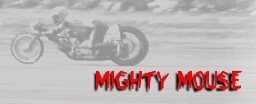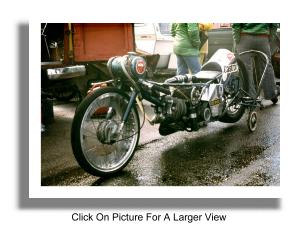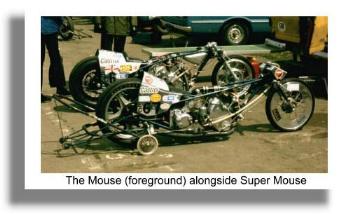 The Mighty Mouse story is a classic tale of drag racing ingenuity.
A skilled rider and engineer who took an idea and gradually developed and
improved upon it until he had done everything he could to wring every last
ounce of horsepower and performance from it. From the mid to late seventies
a bike with, in some cases, a fraction of the capacity of its competitors,
showed allcomers the way to the finish line with alarming regularity. Like
all Drag Racers Brian Chapman was never quite satisfied with his achievements,
always looking for the next increase in performance. Over the years the bike
evolved, the nitro content increased and by the time he retired the Mouse
in 1980, to make way for his new project, he had shaved nearly seven seconds
off its original times.
The Mighty Mouse story is a classic tale of drag racing ingenuity.
A skilled rider and engineer who took an idea and gradually developed and
improved upon it until he had done everything he could to wring every last
ounce of horsepower and performance from it. From the mid to late seventies
a bike with, in some cases, a fraction of the capacity of its competitors,
showed allcomers the way to the finish line with alarming regularity. Like
all Drag Racers Brian Chapman was never quite satisfied with his achievements,
always looking for the next increase in performance. Over the years the bike
evolved, the nitro content increased and by the time he retired the Mouse
in 1980, to make way for his new project, he had shaved nearly seven seconds
off its original times.
Brian built the first incarnation of Mighty
Mouse in the mid-sixties
 having
spent two years competing in various speed trials and sprints on his road
going Vincent Black Shadow, complete with sidecar! Like many he was inspired
by the success of the Dragfests and the growing popularity of Drag Racing
in the UK and decided that it was the direction he was going to move in
next.
having
spent two years competing in various speed trials and sprints on his road
going Vincent Black Shadow, complete with sidecar! Like many he was inspired
by the success of the Dragfests and the growing popularity of Drag Racing
in the UK and decided that it was the direction he was going to move in
next.
Being a big fan of the Vincent he decided
to use a 1951 Comet engine as the powerplant for his purpose-built Drag Racer.
The Comet was a 500cc single cylinder engine that was effectively half a
vee-twin. It was not known for being a high performance engine but Brian
had big plans for the inoffensive unit and set about constructing his machine
in his garden workshop. He decided that he had to keep the bike as low as
possible and fabricated his own tubular frame which allowed him to tilt the
motor forwards by 15 degrees. The motor itself was used as a stressed
member. The new angle of the powerplant meant that modifications had to be
carried out to the oil pick up and rocker gear drainage. The frame was in
two parts with the front section being easily removable to allow easier access
to the engine. Initially forks from a 98cc Moto Guzzi were used. Weight was
kept down by dispensing with the need for an external oil tank. Instead two
pints of mineral oil were carried in the timing chest and in a small extension
attached to it where the original magneto would have been. A dual ignition
system was used featuring two rotating magnet magnetos which were shortened
at their contact breaker ends and coupled back to back. The contact breaker
points were mounted on an external plate and driven from the remote end of
the second magneto. A single carb fed the methanol from the three pint fuel
tank mounted above the clip-on handlebars and an open pipe provided an outlet
for the exhaust gases. The carb was later replaced by a Wal Phillips
injector.
The drive was transmitted to the 18 inch
rear wheel via a single row primary chain, a strengthened AMC clutch and
an AMC Norton gearbox with the first gear pinions removed. This left three
standard ratio gears which were all used on the bikes run up the quarter
mile. Final drive was via a secondary chain to CMA cast alloy rear wheel
with single Vincent drum brake.
To start with the machine had more than
its fair share of teething troubles and Brian recalls that he did more pushing
than riding at some meetings. When the motor did choose to run the bike turned
in times in the region of fourteen seconds. Transport to meetings initially
was achieved by mounting the Mouse in the sidecar of the Black Shadow outfit!
Over the next two years the times gradually improved until early in 1969
when, running with 25% nitro in the tank, Brian got down to 12.3 seconds.
Feeling that he had done as much as he could with a normally aspirated motor
Brian added a Rootes blower in mid '69 and experienced problems almost
immediately as it frequently cooked the vee-shaped drive belts. A toothed
belt was found to be the answer to this problem. The blower was driven at
engine speed and took the fuel mixture from a single ex-Jaguar 1 3/4inch
SU carb. A fuel cut-off valve was fitted which could be operated directly
or from a trigger on the left handlebar. The motor retained standard sized
valves with the exhaust being made from Nimonic 80 material. The original
front forks were replaced by shortened Godden Engineering grass track items
and a hydraulic steering damper was added.
He had some success with individual final
round wins and by the end of 1970 the bike was winning more regularly and
had run a best of 11.10/120.
In August of 1971 Brian took the bike to
the NDRC meeting at Blackbushe. There he put in a run of 10.77 seconds making
Mighty Mouse the quickest single-cylinder dragbike in the world. After that
momentous occasion sub-eleven second runs started to come more frequently
and Brian began to stick the ten second time slips on the wall of his small
workshop.
 In
March 1973 Brian arrived at a Santa Pod practice day and stunned everyone
present by putting in a 10.35 off the trailer. When asked about what
modifications he had carried out on the bike over the winter he replied that
winter had been spent decorating his house and all he had done to the Mouse
was run a feather duster over it! Next month at the Season Opener he ran
the quickest bike time of the day at 10.48. In April at the Springnationals
his luck ran out as the motor blew itself to pieces. Undeterred Brian took
it back to his workshop and began the rebuild. He had been using a lightened
crankshaft, so light, it is reported, that lead had to be added to balance
the flywheel. With a return to the track as soon as possible on his mind
he rebuilt using a standard crank. A move that turned out to be for the better
as the bike instantly ran quicker than ever! The addition of a twin lobe
Marshall supercharger and an increase in the fuel mixture to 75% nitro with
25% methanol meant that the bike was now producing an estimated 125bhp at
9000rpm and returning a fuel consumption of four miles per gallon. The tradition
of putting the ten second timeslips on the workshop wall was getting out
of hand!
In
March 1973 Brian arrived at a Santa Pod practice day and stunned everyone
present by putting in a 10.35 off the trailer. When asked about what
modifications he had carried out on the bike over the winter he replied that
winter had been spent decorating his house and all he had done to the Mouse
was run a feather duster over it! Next month at the Season Opener he ran
the quickest bike time of the day at 10.48. In April at the Springnationals
his luck ran out as the motor blew itself to pieces. Undeterred Brian took
it back to his workshop and began the rebuild. He had been using a lightened
crankshaft, so light, it is reported, that lead had to be added to balance
the flywheel. With a return to the track as soon as possible on his mind
he rebuilt using a standard crank. A move that turned out to be for the better
as the bike instantly ran quicker than ever! The addition of a twin lobe
Marshall supercharger and an increase in the fuel mixture to 75% nitro with
25% methanol meant that the bike was now producing an estimated 125bhp at
9000rpm and returning a fuel consumption of four miles per gallon. The tradition
of putting the ten second timeslips on the workshop wall was getting out
of hand!
Chapman was now running in the Top Bike
class and at Santa Pods August Nationals he amazed everybody by taking the
bike into the nines with a 9.92/139 which was good enough for number two
qualifier just behind Norman Hyde. He backed the nine up with a 9.98/141
in the first round, more than enough consolation for not making it to the
final.
By the end of 1975 Brian had secured the
Top Bike Championship honours for the first time. He continued to run against,
and regularly beat, the quickest bikes in the Country through '76 when
he ran a seasons best of 9.07 in September. A year later at Santa Pods September
International he finally managed to get it into the eights with an 8.96.
He was awarded the BDR&HRA Motorcyclist Of The Year trophy in recognition
of this feat. He also won the ACU Championship outright in 1977 and the following
year recorded the bikes best ever figures of 8.81/157. In 1979 despite still
being competitive Brian was getting beaten more regularly by the multi-motored
Superbikes of John Hobbs, Henk Vink, John Clift and Jeff Byne who were now
knocking on the door of the sevens.
 He decided that he had taken the machine to the
limits of its performance and set about creating a Vee Twin version, with
twin superchargers, to be known as "Super Mouse".....
He decided that he had taken the machine to the
limits of its performance and set about creating a Vee Twin version, with
twin superchargers, to be known as "Super Mouse".....
Mighty Mouse is still in existence today,
in exactly the same guise as when it was retired. Brian has taken it out
a couple of times since then for a quick blast, notably on the Isle Of Man
at the Vincent Owners Club Golden Jubilee celebrations in 1999. The bike
can be seen on display at the Enfield And District Veteran Vehicle Trusts
museum in Whitewebbs Lane, Enfield, Middlesex.
All photographs on this page by Alan Currans
of The
Acceleration Archive

www.trakbytes.co.uk
 The Mighty Mouse story is a classic tale of drag racing ingenuity.
A skilled rider and engineer who took an idea and gradually developed and
improved upon it until he had done everything he could to wring every last
ounce of horsepower and performance from it. From the mid to late seventies
a bike with, in some cases, a fraction of the capacity of its competitors,
showed allcomers the way to the finish line with alarming regularity. Like
all Drag Racers Brian Chapman was never quite satisfied with his achievements,
always looking for the next increase in performance. Over the years the bike
evolved, the nitro content increased and by the time he retired the Mouse
in 1980, to make way for his new project, he had shaved nearly seven seconds
off its original times.
The Mighty Mouse story is a classic tale of drag racing ingenuity.
A skilled rider and engineer who took an idea and gradually developed and
improved upon it until he had done everything he could to wring every last
ounce of horsepower and performance from it. From the mid to late seventies
a bike with, in some cases, a fraction of the capacity of its competitors,
showed allcomers the way to the finish line with alarming regularity. Like
all Drag Racers Brian Chapman was never quite satisfied with his achievements,
always looking for the next increase in performance. Over the years the bike
evolved, the nitro content increased and by the time he retired the Mouse
in 1980, to make way for his new project, he had shaved nearly seven seconds
off its original times.
